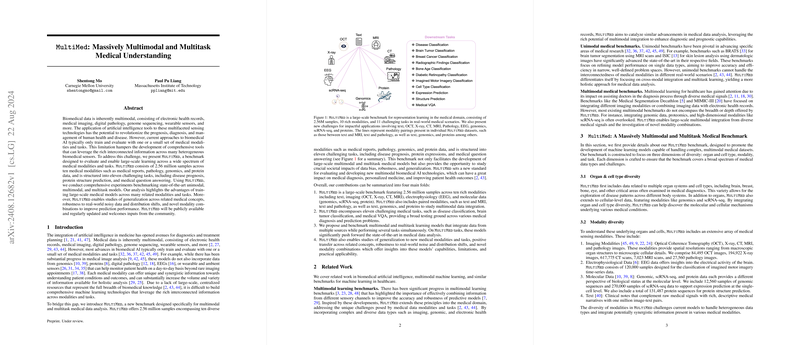Massively Multimodal and Multitask Medical Understanding
Massively Multimodal and Multitask Medical Understanding presents a comprehensive benchmark named \, specifically designed to advance large-scale learning across varied medical modalities and tasks. The primary innovation of this work lies in the scale and diversity of the encapsulated medical data and the breadth of tasks it supports. The benchmark includes 2.56 million samples across ten medical modalities, organized into eleven challenging tasks, ranging from disease prognosis to medical question answering.
Overview
The integration of artificial intelligence into the biomedical domain promises significant improvements in medical diagnosis, prognosis, and management. Yet, current biomedical AI approaches frequently limit themselves to training and evaluating specific modalities or tasks in isolation, thereby failing to exploit the richness of heterogeneous medical data. \ seeks to bridge this gap by facilitating an environment that supports multimodal and multitask learning.
Modalities and Tasks Covered
\ covers a wide range of medical data modalities:
- Imaging Modalities: This includes Optical Coherence Tomography (OCT), X-ray, CT, MRI, and pathology images, providing varying spatial resolutions critical for medical diagnostics.
- Electrophysiological Data: EEG data is used to capture brain electrical activity, essential for tasks like imagined motor imagery classification.
- Molecular Data: This encompasses genomic sequences, single-cell RNA sequencing (scRNA-seq), and protein data to support structure prediction and gene expression analysis.
- Clinical Text: Clinical notes complement other raw medical signals and provide descriptive narratives crucial for medical understanding.
Each modality offers unique and synergistic information essential for a holistic understanding of patient health and disease outcomes.
The eleven tasks supported by \ include:
- Disease classification
- Brain tumor classification
- Breast cancer classification
- Radiographic findings classification
- Bone age classification
- Diabetic retinopathy classification
- Imagined motor imagery classification
- Cell type classification
- Expression prediction
- Protein structure prediction
- Medical visual question answering
These tasks are designed to test model adaptability across various medical domains and capture the interconnected complexities within multimodal medical data.
Experimental Evaluation & Results
The authors conducted extensive experiments to benchmark state-of-the-art unimodal, multimodal, single-task, and multitask models on \. The experimental results demonstrate the superiority of multimodal multitask learning methods. Some notable findings include:
- Significant improvements in disease classification and medical visual question answering, with accuracies increasing from 45.39% to 61.89% and 49.35% to 69.38%, respectively, when employing multimodal multitask models.
- On protein structure prediction and gene expression prediction tasks, the performance improved convincingly, demonstrating the efficacy of integrating multiple data types for these complex tasks.
These results underscore the advantage of leveraging the complementarity of various medical data modalities in a unified learning framework.
Implications and Future Directions
The implications of the research are both practical and theoretical. Practically, the benchmark facilitates the development of more robust and accurate medical AI models that can handle diverse real-world data, potentially improving patient outcomes. Theoretically, it supports research into generalization capabilities, data robustness, and leveraging novel modality combinations for enhanced prediction performance.
Future research directions indicated by the paper include:
- Exploration of more sophisticated multimodal fusion techniques.
- Development of scalable and computationally efficient models.
- Addressing algorithmic biases to ensure fair and equitable model performance across diverse patient demographics.
- Enhancing interpretability and explainability of AI models to foster trust and adoption in clinical settings.
Conclusion
The \ benchmark sets a new standard for evaluating and advancing multimodal and multitask AI technologies in the medical domain. By providing a large, diverse dataset and a suite of comprehensive evaluation tasks, it paves the way for the development of more holistic and effective AI-driven medical tools, which could significantly impact various aspects of healthcare, from diagnosis to personalized treatment plans. The continuous updates and community involvement encouraged by the authors promise to keep the benchmark relevant and at the forefront of medical AI research.
